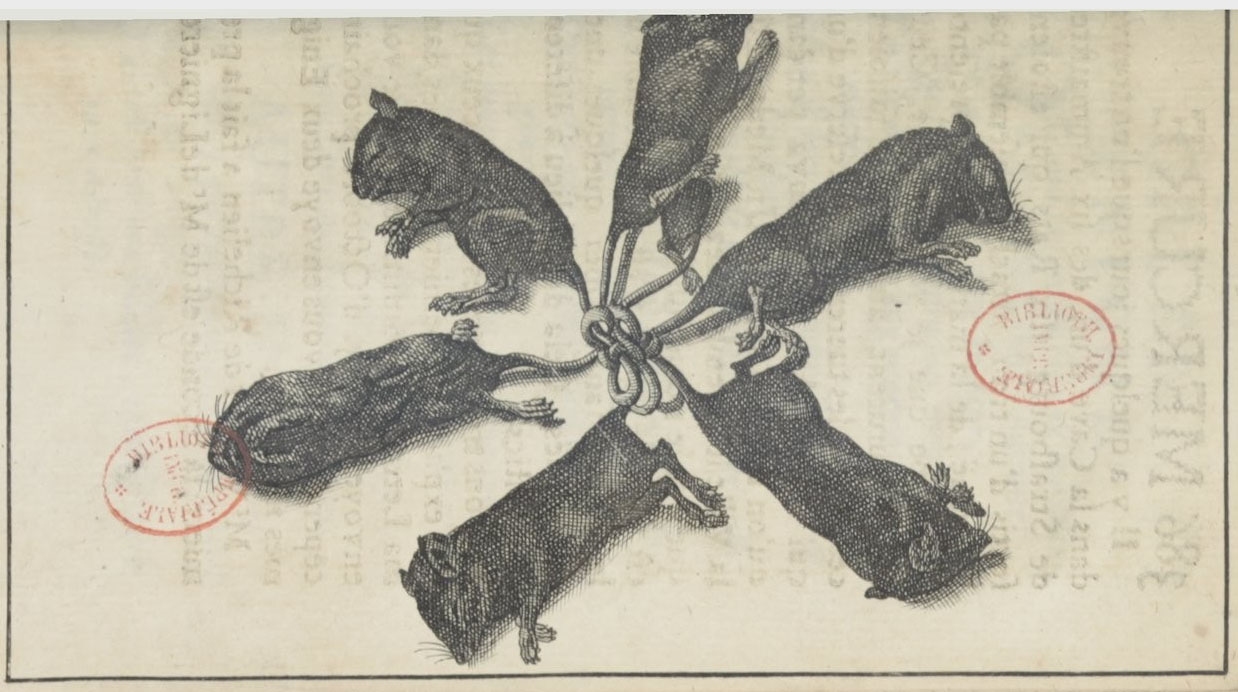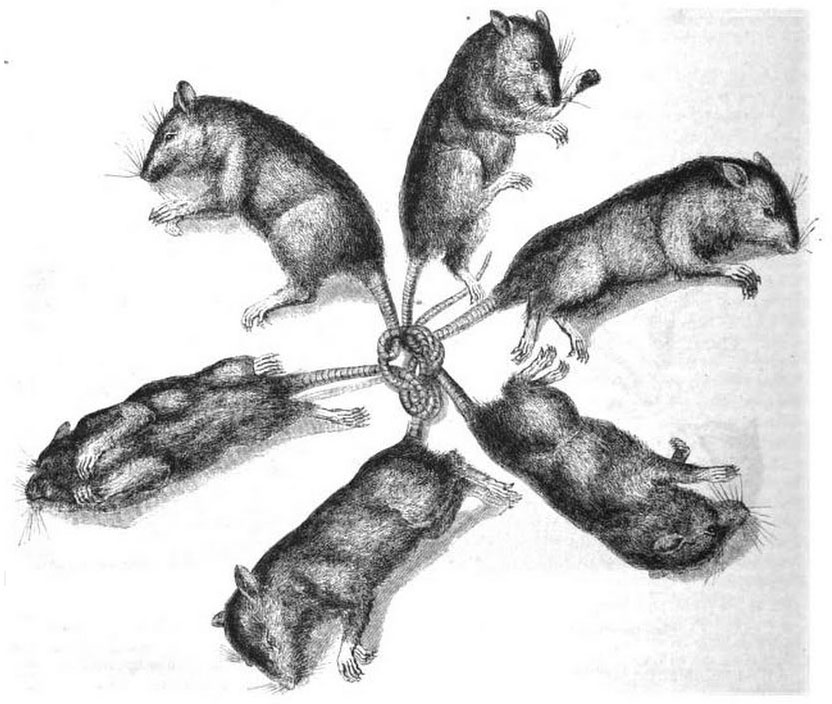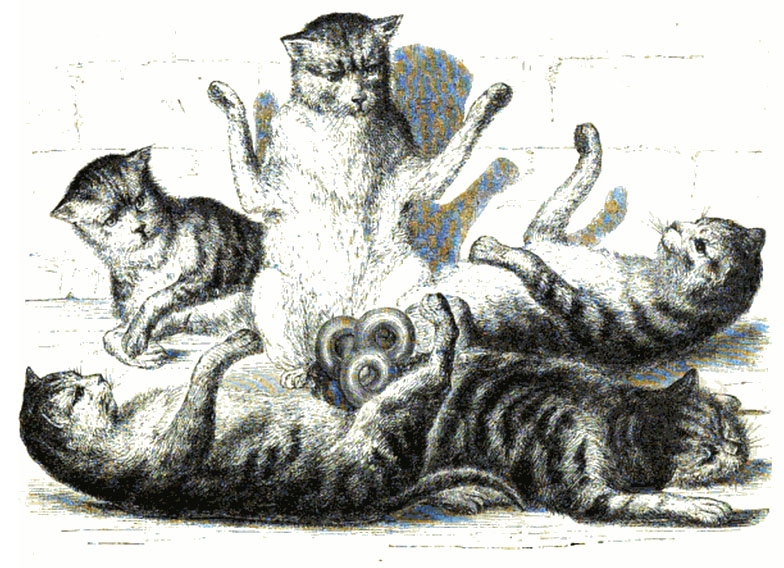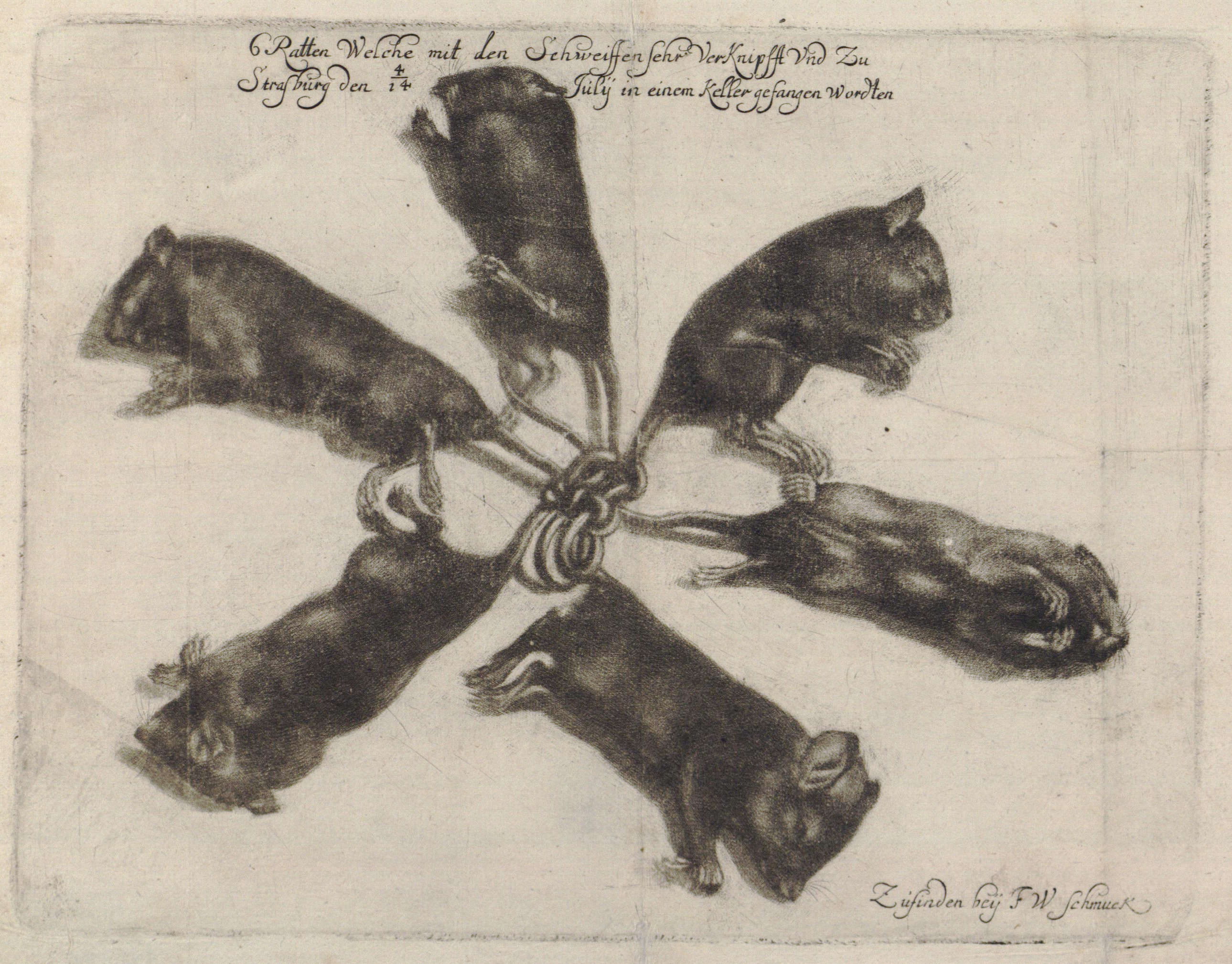1683, July 4-14: The Strasbourg Roi de Rats
The story started simple enough. In the September 1683 issue of the French magazine Mercure Galant ['Gallant Mercury'], it was noted that six rats who were tied together by their tails had been discovered in the cellar of the house of one of the six 'Ammaistres' (Magistrates) of Strasbourg, France. When the rats were discovered, apparently due to their squealing, they were immediately all killed excepting for one that managed to free itself from the tangle and run away. The strange find was embalmed by a doctor, and an illustration of the strange find was sent to the magazine along with the report. Here's the illustration:

The illustration in the 1683 issue of Mercure Galant. [Larger version here]
As you can see, the top rat here has lost its head; this is because it was towards the inner fold of the magazine, so unless the book was fully split open -- which I doubt anyone wants to do with their copy now! -- part of the illustration is not available for view. And that's all there was to say about this odd occurrence... at the time.
Once Again, but Different
In 1854, the story grew some... but it's a bit suspicious.
The tale of the Strasbourg 'Roi de Rats' -- French for 'Rat King' -- was revisited in the French magazine Magasin Pittoresque ['Picturesque Shop'] of January 1854, in which is described a "Curious Print" from the collection of a Mr. Hennin which included inscriptions above and below the following illustration:

The illustration in the 1854 issue of Magasin Pittoresque. [Larger version here]
I quote:
"The one [inscription] at the top announces that this wonderful and strange monstrosity of a frightful meeting of rats, found on July 4-14, 1683, in a cellar, in Strasbourg, has been copied from an exact drawing, which has thus been engraved for the astonishment and the examination of each one."
The inscription at the bottom of the illustration went into much more detail, so I summarize: after stating the appearance of the rat king was a divine sign, we are told that it was found in the cellar of the Magistrate Würzens. A 'friend of the publisher' had stated the rat king had been taken to the Strasbourg City Hall for public display, after which one of the rats escaped as the others were killed. This was then followed by eight or so verses regarding religious and moral implications to be taken from the event that the Magasin Pittoresque didn't feel the need to detail out, which is understandable.
The Magasin Pittoresque then claims that the Mercure Gallant of September 1683 "gave a narrative of this fact, but with less extensive details; there is also an exact copy of the print..." so implying that Mr. Hennin's print was the more precise of the two, and that the facts of the story as they gave them were more correct than in the much earlier magazine.
While the two illustrations are obviously related, the relationship between them is not obvious. What we have is this: 171 years after the event happened and the Mercure Gallant reported it, a different magazine is claiming to have more precise information from a print of unknown provenance. So the new details presented with it -- the date of July 4-14 for the occurrence and the name of the magistrate involved, Würzens -- are interesting, but not reliable.
While the German name "Würzens" as a magistrate of a French town initially bothered me, a check showed that Strasbourg is in the Alsace region of France, which is on the border with Germany... and traditionally has benefited from a mix of the two cultures and regions, so German names in the area are presumably normal.
Oh, and one more little thing that people quoting the 1854 account seem to always forget to mention: the magazine presented one more print from Mr. Hennin's collection, which was also claimed to come from Strasbourg in 1683. Look...

We are told this cat print has an inscription that claims this "new miraculous and horrible monstrusness" prodigy appeared in Strasbourg after the rats were found, on August 5-15, 1683. This is also followed by a warning regarding bad human behavior, and more verses that the Magasin Pittoresque chose not to share.
Given that we can see the tail of one of the cats in the bottom of the picture, it would appear the 'tail tangle' was a detail added after the fact to an existing print of cats, likely added for its inclusion in the 1854 article... and frankly, it doesn't add a vote of confidence to the article's new details regarding the Strasbourg rat king! Many new accountings of the Strasbourg rat king, however, repeat the new details from the 1854 Magasin Pittoresque article while claiming they came from the earlier 1683 Mercure Gallant article to give them false authority.
And One More Time, in German
On June 2, 2011, the following image was posted into the Wikimedia Commons website by user 'FA2010':

What, again...? [Larger version here]
Although a link is provided that used to point at the file's original source, it no longer works. The only other details given are the German text in the picture, and an additional note given in the title for the picture. The German text is:
"6 Ratten Welche mit den Schweiffen sehr VerKnipfft Vnd Zu Strasburg den 4/14 July in einem Keller gefangen wordten. Zufinden bey F. W. Schmuck"
...which Google translates as "6 rats which are very connected with the tails and to Strasburg the 4/14 July caught in a cellar. Zufinden bey F. W. Schmuck." This last part appears to be peculiar to 17th Century publishing as meaning "printed by" or "published by." The name given for the file is the first part of the German above, followed by "Verleger: Friedrich Wilhelm Schmuck, um 1683" instead of the 'Zufinden' line at the bottom of the picture. This new bit translates as "Publisher: Friedrich Wilhelm Schmuck, around 1683," so in both cases F. W. or Friedrich Wilhelm Schmuck is attributed as the publisher of the illustration, though no direct evidence is given to support the claim it was published around 1683.
After a LOT of digging, I found that the original of this illustration can be found in the website for the Bibliothèque nationale de France. As I was digging, I discovered that Friedrich Wilhelm Schmuck was an active publisher around 1683; I've seen several titles he was involved with, all dating from the 1670~1690 year range. The notes on the illustration from the "BnF" website (a shortening of the library's name that the website itself uses) identify Schmuck as both the publisher and the illustrator in this particular case, and it is presented as just a single page rather than as part of a book... but I'll bet this single page sold well in 1683!
Also according to the library's notes, their copy of the illustration came from a collection of prints that were gathered in 1788-1810... one hundred years after the event. Their notes also identify Schmuck as the illustrator, but I doubt this as I've seen no other examples of art by him... just books he has published.
It's interesting to note that Schmuck's illustration is actually reversed left to right from the illustrations above; and the individual details of the rats in Schmuck's illustration are very closely aligned to the details in the 1683 picture from the Mercure Gallant. Again, while the two illustrations are obviously related, it's not clear how... it would seem that one illustration must be a copy of the other illustration, but which came first may never be known! One sneaky thought does come to mind, however: perhaps Schmuck had the image reversed to bypass copyright laws on a technicality to sell someone else's work; just a thought.
Anomalies -- the Strange & Unexplained, as well as my other website -- Monsters Here & There -- are supported by patrons, people like you! All new Anomalies articles are now posted for my patrons only, along with exclusive content made just for them. You can become a patron for just $1 a month!
|








